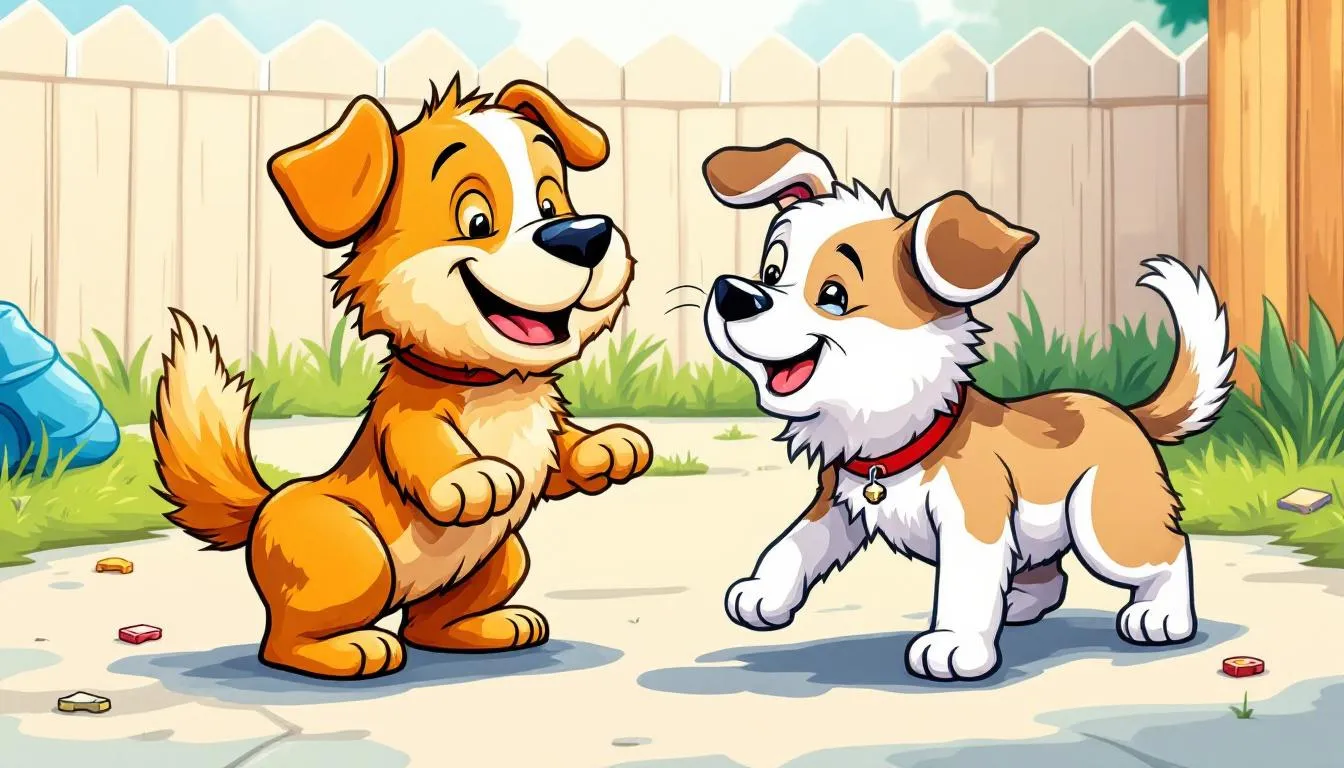Want to know what your pet is really feeling? Understanding pet body language can help. This guide will teach you to read the signs and signals dogs and cats use to communicate their emotions, from happiness to stress.
Key Takeaways
- Understanding pet body language, including posture, ear positions, and tail movements, is essential for interpreting their emotional states and improving interactions.
- Recognizing signs of stress and fear in pets allows for timely intervention, fostering a secure environment and preventing aggressive behaviors.
- Effective communication with pets through consistent vocal cues and body language enhances mutual understanding and strengthens the human-animal bond.
Dog’s Body Language: Key Indicators

Dogs primarily communicate through body language, so observing all aspects of their physical behavior helps accurately interpret their emotions. Understanding a dog’s body language requires examining:
- Their overall posture
- Facial expressions dogs
- Tail movements
- Ear positions This approach provides insights into their emotional state, allowing you to respond appropriately to their needs.
Deciphering dog body language not only helps in predicting behavior but also in developing trust and respect between you and your canine companion. Recognizing how dogs rely on body language to express whether your dog feels relaxed, stressed, fearful, or aggressive can significantly improve your interactions and prevent potentially harmful situations. Understanding canine body language is essential for effective communication.
In the following subsections, we’ll delve into specific indicators of a dog’s body language, including:
- Tail wagging
- Signs of a relaxed dog
- Stress signals
- Fear
- Aggression Each aspect provides valuable clues about your dog’s emotional state and intentions, including your dog’s emotional state.
Tail Wagging
A wagging tail is often seen as a sign of a happy dog, but it can indicate various emotions such as happiness, arousal, or even frustration. To accurately interpret a dog’s tail wagging, it’s crucial to consider:
- The tail’s position: a higher tail often signifies confidence.
- The speed of wagging: a faster wag indicates higher arousal levels.
- The direction of wagging.
Understanding breed-specific natural tail positions is also important, as what might be a relaxed position for one breed could be different for another. A ‘helicopter tail wag,’ where the tail moves in a circular motion, usually signifies a particularly happy mood. Paying attention to these details helps you understand what your dog is trying to communicate.
Relaxed Dog
A relaxed dog typically displays the following signs:
- A fluid body posture with a slightly open mouth, indicating contentment
- Soft eyes
- A neutral forehead
- Ears in their natural position, hanging slightly loose forward, showcasing relaxed ears. These signs indicate that your dog is calm and happy, reflecting relaxed body language.
Eye contact with your dog enhances their sense of security and trust. A relaxed dog might also display the following signs, inviting a belly rub:
- Rolling on its back
- Gently wagging tail
- Slightly open mouth
Recognizing these signs can help you create a positive and reassuring environment for your pet, as a dog likes to feel secure.
Stressed Dog
Stress in dogs can manifest through various signs, including:
- Lip licking
- Yawning
- Avoiding eye contact
- Self-grooming behaviors, such as excessive licking
These displacement behaviors are often coping mechanisms for anxiety.
Other indicators of stress include changes in a dog’s eye and ear position, such as dilated pupils and pinned-back ears. Recognizing these signs allows for timely intervention and improves your dog’s well-being. By addressing the root causes of stress, you can help your dog feel more secure and comfortable.
Fearful Dog
Fearful dogs often exhibit a stiff posture, with their bodies hunched and tails tucked between their legs. Specific signs of fear include a dog’s ears tucked back against the head and ‘whale eye,’ where the whites of the eyes are visible. A tightly closed mouth with pulled-back corners is another indication that a dog is feeling fearful.
These calming signals guide you in providing comfort and support to alleviate your dog’s fear. Avoiding sudden movements and speaking in a calm, soothing voice can make a significant difference in how your dog perceives a potentially frightening situation.
Aggressive Dog
Aggression in dogs can be identified through several key indicators, including:
- Raised hackles
- A tense jaw
- Direct eye contact
- A rigid body posture
A dog showing a rigid body posture with weight shifted forward may be displaying offensive aggression. If a dog’s warning that the dog freezes is not respected, it may escalate to growling, snapping, or biting.
Hard eyes in a dog indicate a negative state of mind, suggesting aggression or discomfort. Identifying these signs early helps prevent aggressive incidents and ensures safety for your dog and others.
Cat Body Language: Decoding Feline Signals

Cats are known for their enigmatic behavior, and understanding their body language can be quite a challenge. Cats can express at least 25 distinct emotional states, making it essential for owners to learn how to interpret these signals accurately. A cat’s overall body position, vocalizations, and specific physical cues all provide key insights into their emotional state.
Veterinarians often assess a cat’s emotional state by considering both vocalizations and body language, as these elements provide context to each other. Understanding these signals allows you to better respond to your cat’s needs and foster a harmonious relationship.
The following subsections explore specific aspects of cat body language, including tail positions, ear movements, and eye expressions. Each of these elements plays a crucial role in deciphering your cat’s emotions and intentions.
Tail Positions
A cat’s tail position can reveal a lot about its emotional state. For instance, a relaxed cat typically has its tail extended and flat, indicating comfort and contentment. Conversely, a cat with an upright tail is signaling a friendly and confident demeanor, inviting interaction.
A puffed tail can indicate excitement, fear, or aggression depending on the context. Understanding these tail positions can help you gauge your cat’s mood and respond appropriately to their needs.
Ear Movements
Cats’ ear positions are critical indicators of their emotional state. Upright ears suggest that a cat is curious and alert to its surroundings. On the other hand, flattened ears typically indicate that a cat is feeling fearful or threatened.
Certain aggressive postures may also be signaled through ears that are held back or flat against the head. By paying attention to your cat’s ear movements, you can better understand their feelings and intentions.
Eye Expressions
Cats utilize their eyes as a form of communication, conveying mood and intentions. Slow blinking in cats is often interpreted as a sign of affection and trust. These eye expressions help you build a stronger bond with your feline friend and provide necessary comfort.
Recognizing Stress and Anxiety in Pets

Recognizing stress in pets is crucial to address problems before they escalate. Stress in dogs and cats can manifest in various ways, and understanding these signs is essential for their well-being. Common signs of distress in dogs include pacing, excessive yawning, and a tired hunched posture.
If a dog frequently displays signs of anxiety, consider the following steps:
- Consult a professional behaviorist.
- Create a safe environment.
- Use positive reinforcement techniques to help modify the dog’s behavior when they show signs of fear or discomfort.
Ignoring a dog’s warning signals may lead to a threat of escalation into more aggressive behaviors.
Signs of Stress in Dogs
Common signs of stress in dogs include lip licking, yawning, and avoiding eye contact. Displacement behaviors, such as sniffing the ground or shaking off, help them cope with anxiety. Stressed dogs may also exhibit increased pacing or shaking as physical manifestations of anxiety.
Recognizing these signs allows for timely intervention and improves your dog’s well-being. By addressing the root causes of stress, you can help your dog feel more secure and comfortable.
Signs of Stress in Cats
Hiding is a common response in cats experiencing stress, as they seek safe spaces to cope. Changes in vocalizations, such as increased meowing or yowling, can signal that a cat is under stress. When a cat’s tail is held low, it often indicates fear or anxiety.
Identifying stress in cats is crucial for their well-being, as they often exhibit behaviors to communicate discomfort. Understanding these signs allows you to provide the support needed to help your cat feel secure.
Understanding Play Behavior in Pets

Differentiating between play and aggression in pets is essential for understanding play behavior. Playful interactions are crucial for a pet’s mental and physical well-being. However, it’s important to recognize when play has escalated into fighting, as indicated by stiff, tense postures, growling, or one pet trying to escape.
By understanding these behaviors, you can foster positive play experiences and provide examples of how to prevent problems and intervene appropriately when necessary.
Dog Play Bow
The play bow is a signal to initiate play in dogs. It is characterized by the front paw legs being stretched forward and the rear end raised, indicating a wish to play. Recognizing a play bow enhances interactions and fosters playfulness between dogs and humans.
This signal allows you to engage in play with your dog, strengthening your bond and providing stimulation.
Cat Play Signals
Cats show playful intentions through behaviors like pouncing, chasing, and swatting at objects or other animals. These behaviors mimic hunting actions and indicate that a cat is in a playful mood.
These play signals help you engage in interactive play with your cat, providing necessary mental and physical exercise.
Communicating Back to Your Pet

Effective communication with your pet is crucial for enhancing mutual understanding and strengthening your bond. Using consistent vocal cues and body postures can help clarify communication between you and your pet. Dogs respond well to positive reinforcement, making treats and praise effective tools for communication.
Understanding and responding to your pet’s body language helps create a harmonious relationship and address behavioral issues early.
Effective Human-to-Pet Communication
Using consistent vocal cues alongside body language can improve your dog’s understanding of commands. Effective communication with pets is crucial for understanding and strengthening your bond with them.
Paying attention to your pet’s signals and responding appropriately fosters a positive and trusting relationship.
When to Seek Professional Help
Identifying body language signals in pets is crucial for spotting health or behavioral issues that may need professional intervention. Some common signs that a dog is in pain are:
- Reluctance to move and a stiff gait
- Excessive panting
- Reduced appetite
- Unusual vocalization
- Aggression
- Withdrawal
If your pet exhibits persistent signs of stress or concerning animal behaviors, contact a veterinarian or professional behaviorist to prevent escalation in animals.
Summary
Understanding pet body language is essential for fostering a strong bond and ensuring the well-being of your furry friends. By paying attention to their signals and responding appropriately, you can create a harmonious relationship and prevent misunderstandings. Keep observing, learning, and communicating with your pets to ensure a happy and healthy life together.
Frequently Asked Questions
How can I tell if my dog is happy?
To determine if your dog is happy, observe their body language; indications include a relaxed posture, slightly open mouth, soft eyes, and a gently wagging tail. Additionally, a happy dog will often seek out interaction with you.
What does it mean if my cat’s tail is puffed up?
A puffed tail in cats typically signals excitement, fear, or aggression. It’s important to consider the overall context and additional body language cues to accurately assess your cat’s emotional state.
Why is my dog licking its lips and yawning frequently?
Frequent lip licking and yawning in your dog likely indicate stress or anxiety. Identifying the underlying cause and addressing it is crucial for your pet’s well-being.
How do I know if my pet’s playful behavior has turned into aggression?
Playful behavior has turned into aggression if you notice signs such as stiff postures, growling, hissing, flattened ears, one pet attempting to escape, or one pet pinning the other down. Monitor these behaviors closely to ensure the safety of all pets involved.
When should I seek professional help for my pet’s behavior?
You should seek professional help for your pet’s behavior when you notice persistent signs of stress, aggression, or other concerning behaviors, as early intervention can prevent further issues.

